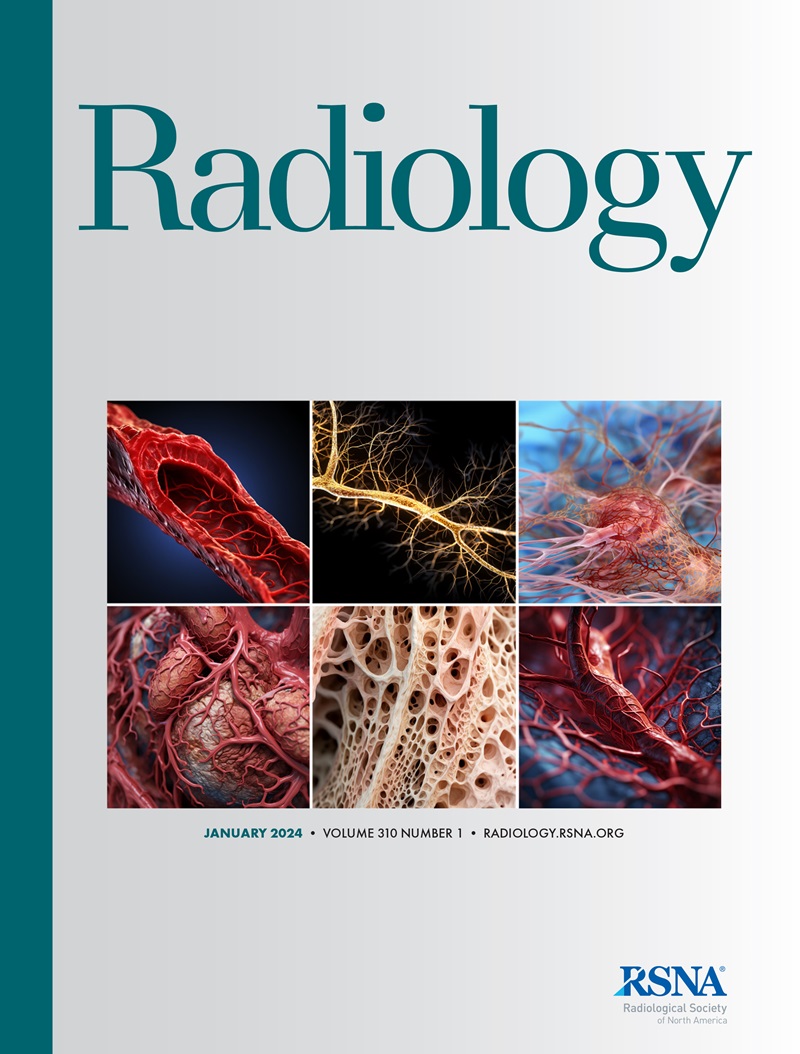Stent-Assisted Angioplasty in Symptomatic Intracranial Stenosis without Adjacent Branch Atheromatous Disease: A Randomized Trial with Patients Selected by Using Three-Dimensional Rotational Angiography.
IF 12.1
1区 医学
Q1 RADIOLOGY, NUCLEAR MEDICINE & MEDICAL IMAGING
引用次数: 0
Abstract
Background Use of stents for symptomatic intracranial atherosclerotic stenosis (ICAS) was found to be harmful in previous randomized trials, in which perforator stroke was a notable procedural complication. It was unclear if excluding patients with concurrent branch atheromatous disease (BAD) adjacent to the target intracranial stenosis may reduce perforator jailing. Purpose To compare the safety and efficacy of intracranial stent placement (hereafter, stenting) versus medical therapy in participants with high-grade symptomatic ICAS and adjacent BAD excluded with three-dimensional rotational angiography (3DRA). Materials and Methods In this single-center, prospective, randomized, open-label, blinded end-point trial conducted in Hong Kong from 2006 to 2022, participants with transient ischemic attack (TIA) or ischemic stroke attributed to severe ICAS (70%-99%) were randomized to intracranial stenting under local anesthesia or medical therapy within 6 weeks of a qualifying event. Participants underwent 3DRA, and participants with severe BAD adjacent to the target stenosis were excluded. The primary end point was a composite of TIA, ischemic stroke, intracranial hemorrhage, and death within 30 days or any ischemic stroke from 30 days to 1 year. The secondary end points were ischemic stroke or TIA in the same artery territory (SIT), any strokes, and percentage of stenosis at 1 year. Cumulative incidences of end points were compared using Cox proportional hazard models. Results A total of 150 participants (mean age, 61 years ± 9.5 [SD], 45 female participants) were randomized into stenting (n = 74) and medical therapy (n = 76) groups. There was no evidence of between-group differences in the cumulative incidence of the primary end point (stenting vs medical therapy, respectively: 12 of 74 [16%] vs 18 of 76 [24%]; hazard ratio [HR], 0.66 [95% CI: 0.32, 1.36]; P = .26), SIT (nine of 74 [12%] vs 15 of 76 [20%]; HR, 0.59 [95% CI: 0.26, 1.35]; P = .21), or any strokes at 1 year (10 of 74 [14%] vs 17 of 76 [22%]; HR, 0.57 [95% CI: 0.27, 1.24]; P = .16). Percentage stenosis at 1 year was lower with intracranial stenting (33% ± 22 vs 67% ± 18, respectively; P < .001). Conclusion In participants with symptomatic ICAS without BAD adjacent to the target stenosis, intracranial stenting did not result in a reduction in the cumulative incidence of stroke or death at 30 days or stroke from 30 days to 1 year. Center for Clinical Research and Biostatistics Clinical Trial Registry (The Chinese University of Hong Kong)/Chinese Clinical Trials Registry Identifier: CUHK-CCT00116 Published under a CC BY 4.0 license. Supplemental material is available for this article. See also the editorial by Wojak in this issue.支架辅助血管成形术治疗无相邻分支动脉粥样硬化的症状性颅内狭窄:一项采用三维旋转血管造影选择患者的随机试验。
背景:在之前的随机试验中发现,使用支架治疗症状性颅内动脉粥样硬化性狭窄(ICAS)是有害的,其中穿支卒中是一个显著的手术并发症。目前尚不清楚排除与目标颅内狭窄相邻的并发分支动脉粥样硬化疾病(BAD)患者是否可以减少穿支监禁。目的比较经三维旋转血管造影(3DRA)排除的重度症状性ICAS和邻近BAD患者颅内支架置入术(以下简称支架置入术)与药物治疗的安全性和有效性。材料和方法在2006年至2022年在香港进行的这项单中心、前瞻性、随机、开放标签、盲法终点试验中,由严重ICAS引起的短暂性脑缺血发作(TIA)或缺血性脑卒中患者(70%-99%)在合格事件发生后6周内随机接受局部麻醉或药物治疗的颅内支架植入。参与者接受3DRA治疗,并排除目标狭窄附近有严重BAD的参与者。主要终点是TIA、缺血性卒中、颅内出血、30天内死亡或30天至1年内任何缺血性卒中的复合终点。次要终点是同一动脉区域(SIT)的缺血性卒中或TIA,任何卒中和1年内狭窄的百分比。终点的累积发生率采用Cox比例风险模型进行比较。结果150例患者(平均年龄61岁±9.5岁[SD],女性45例)随机分为支架置入术组(n = 74)和药物治疗组(n = 76)。主要终点累积发生率(支架植入与药物治疗)在组间无差异:74例中有12例[16%]vs 76例中有18例[24%];风险比[HR], 0.66 [95% CI: 0.32, 1.36];P = .26), SIT(74人中的9人[12%]vs 76人中的15人[20%];Hr, 0.59 [95% ci: 0.26, 1.35];P = .21),或1年内任何中风(74例中有10例[14%]vs 76例中有17例[22%];Hr, 0.57 [95% ci: 0.27, 1.24];P = .16)。颅内支架术1年狭窄率较低(分别为33%±22 vs 67%±18);P < 0.001)。结论:在目标狭窄附近无BAD的症状性ICAS患者中,颅内支架植入不会导致30天内卒中或死亡的累积发生率降低,也不会导致30天至1年内卒中的累积发生率降低。临床研究及生物统计中心临床试验注册中心(香港中文大学)/中国临床试验注册中心编号:CUHK-CCT00116以CC BY 4.0授权发布。本文有补充材料。请参阅Wojak在本期的社论。
本文章由计算机程序翻译,如有差异,请以英文原文为准。
求助全文
约1分钟内获得全文
求助全文
来源期刊

Radiology
医学-核医学
CiteScore
35.20
自引率
3.00%
发文量
596
审稿时长
3.6 months
期刊介绍:
Published regularly since 1923 by the Radiological Society of North America (RSNA), Radiology has long been recognized as the authoritative reference for the most current, clinically relevant and highest quality research in the field of radiology. Each month the journal publishes approximately 240 pages of peer-reviewed original research, authoritative reviews, well-balanced commentary on significant articles, and expert opinion on new techniques and technologies.
Radiology publishes cutting edge and impactful imaging research articles in radiology and medical imaging in order to help improve human health.
 求助内容:
求助内容: 应助结果提醒方式:
应助结果提醒方式:


